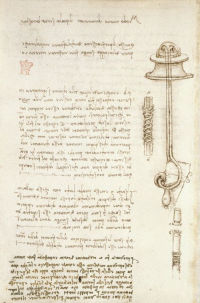Remaking Nature Click on the thumbnails to explore the trail
Read more about this trail (expand)
Leonardo’s ultimate aim was to imitate nature by remaking nature, as opposed to slavishly copying natural forms. This would require a profound understanding of the relationship between the effects of natural appearances and the underlying causes that gave rise to their form. Equipped with this knowledge, Leonardo believed he could create forms equitable to those found in nature, many of which might be of great service to man.

- Enlarge
- Fol 24v - Study of a floater with breathing tubes for a diver © Permission by British Library 263
Codex Arundel 1490s–c1518
Leonardo designed ingenious aquatic equipment and contrived schemes for clandestine underwater attacks on Turkish invaders.
His first proposal was to send a group of submarines to “gore the flanks” of Turkish ships held at anchor. He elaborated the idea, suggesting that divers could be sent to do the job instead. They could breathe by means of the device illustrated here comprised of a tube that ran from a mask to the surface which floated with the aid of a cork. The idea was rejected because the enemy might see the tubes of the divers.
As an alternative, Leonardo designed a diving suit, which he described in great detail, which could be sewn up at home by “a simple-minded fellow”. The suit covered the entire body and had a vent to urinate and a breastplate containing a tank.
Divers wearing such suits and armed with knives could walk along the sea bed to cut holes in the hulls of invading ships. Later Leonardo worried about the idea and the possible misuse of his inventions in a terrible war of the future that he foresaw taking place under the sea.
In Leonardo's words
How and wherefore I do not describe my method of remaining underwater and how long I can remain without eating I do not publish or divulge, by reason of the evil nature of men, who would use them for assassinations at the bottom of the sea by piercing a hole in the bottom of a ship, and sinking them, together with the men in them.
Leonardo described part of this manuscript as “a collection of notes without order, composed of many pages which I have copied, hoping then to put them in their appropriate place, according to the topics that they treat”.
The sheets of this manuscript deal with a variety of mainly technical and mechanical subjects, such as weights and geometry, as well as architectural studies related to the residence of Francis I at Romarantin, France. The manuscript also contains an ingenious design for a device for breathing under water.
The Codex Arundel is a bound manuscript containing 238 pages of various sizes that have been gleaned from other manuscripts.
- Medium Pen and ink on paper
- Size 21 x 15 cm
- Location British Library










